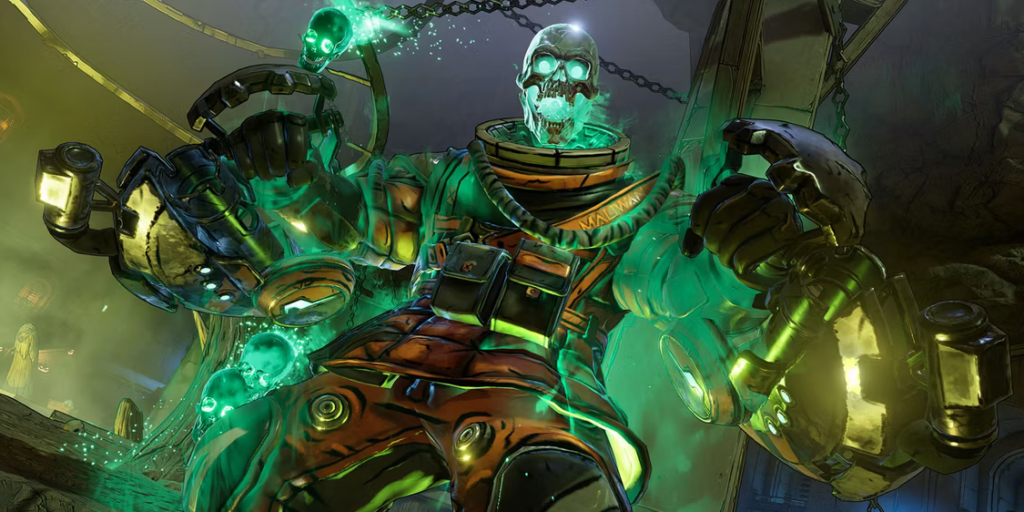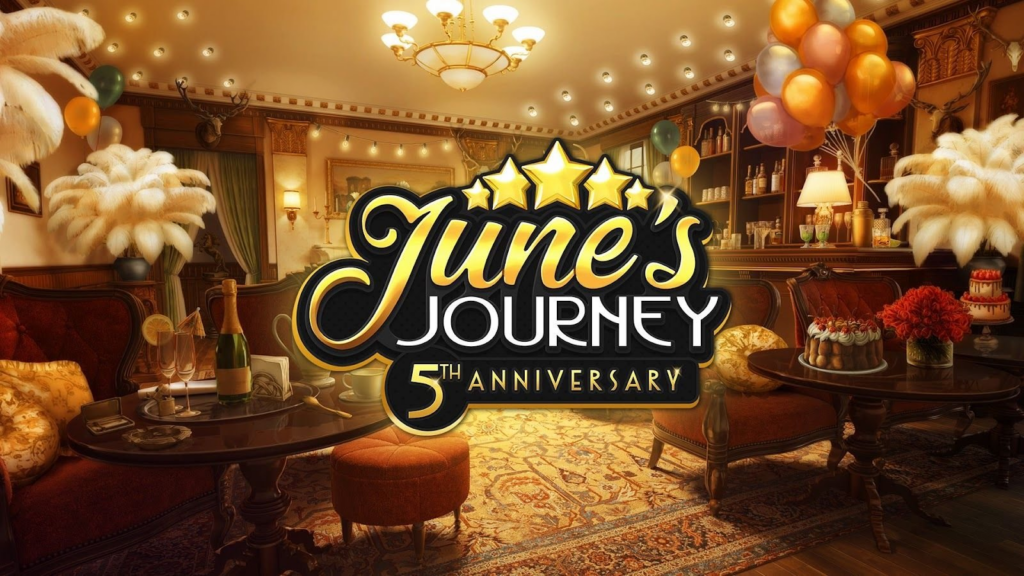
As the web3 industry continues through a prolonged bear market and many companies have re-evaluated their plans around blockchain technology, large corporations are continuing to push forward and explore this new frontier and charting their own course for those to follow. Chief among them is none other than Starbucks, which last year launched an NFT product the company called the Starbucks Odyssey Experience.
Why look at Starbucks Odyssey? Simply put, anything can be a game, and gaming extends beyond just apps on a phone or software on a desktop. The proliferation of "gamification" demonstrates the impact of gaming across multiple industries and formats. Studying lessons from outside gaming can serve as inspiration and provide tips on how to reach and connect with mass audiences, and bringing those learnings back can build a better gaming experience for all.
For those that are less versed in the Starbucks ecosystem, Starbucks has long had an industry-leading Starbucks Loyalty program in which devotees can earn coveted Stars by completing various challenges and games. These Stars can then be later redeemed for coffee, food, and other goodies.
Is Starbucks coffee chain the hidden vanguard of web3? At first glance, Starbucks and web3 may seem like an unlikely pairing, but one of Starbucks’ underlying philosophies is being the "Third Place." Specifically, described by Starbucks as "a place between home and work where you feel the warmth of connection over coffee, community, and belonging."
So it’s almost natural that Starbucks would extend this philosophy even further by utilizing web3, which not only allows loyalty members to connect with Starbucks as before, but also with one another. The company’s stated vision is "to create a place where our digital community can come together over coffee, engage in immersive experiences, and celebrate the heritage and future of Starbucks." All of this, of course, is centered around coffee.
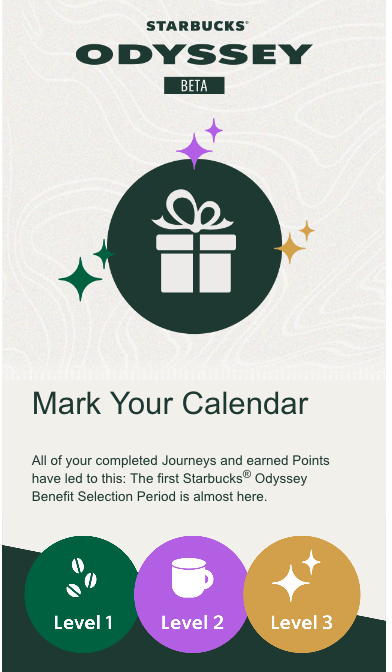
The Starbucks Odyssey Experience is in its simplest terms a loyalty reward program on web3 steroids. It was announced in September 2022 with a waitlist and opened in early December to a small group of early members. It's currently still in beta and has an ongoing waitlist. The program is built on top of the existing widely popular Starbucks Loyalty Program. Using the same credentials to link the two systems together, Odyssey blends an achievement-based system called Journeys with a set of tasks and challenges; each task earns Points. Completing the entire Journey will earn a Stamp.
These Stamps are NFTs minted on the low-cost, eco-friendly proof-of-stake L2 Polygon Chain and hosted by Nifty Gateway, an NFT marketplace owned by the Gemini crypto exchange. Stamps serve as experience badges and mementos that can be freely traded. They also have associated Odyssey Point value that transfers with the Stamp if it’s later bought or sold. These Points ultimately determine the Benefit Level, unlocking unique perks such as exclusive merch or special events. The first selection period opened at the end of April.
With that brief overview, let's delve into five top lessons from the beta Starbucks Odyssey Experience.
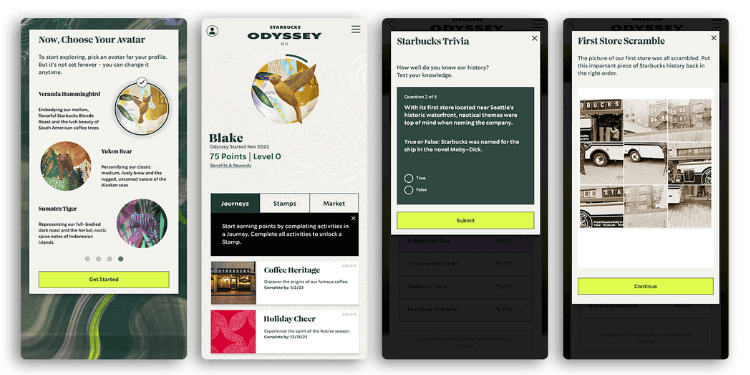
Lesson 1: Focus on the Fun!
During the last crypto and NFT hype cycle, one of the biggest issues was the excessive focus on earning and other monetary aspects of web3 projects. In many cases, this overshadowed the fun or gaming side and once the monetary incentive diminished or disappeared, we saw many projects fall apart. Instead, Starbucks Odyssey takes the opposite approach and focuses on the fun.
Starbucks Odyssey’s goal isn't trying to supplant its main business of selling coffee, nor is it trying to necessarily boost earnings. Instead, the program is purposely designed as a mechanism to deepen the relationships with its most loyal members and introduce new members into its ecosystem in a way that feels fun, like a game.
As mentioned before, Journeys is a gaming achievement system designed to drive engagement, education, and ultimately loyalty with players by incentivizing them to complete tasks and earn Stamps and Points — Stamps being NFTs that have tradable value with associated Points value. Points determine the Benefit Level. Within each Journey are simple game mechanics such as:
- Trivia
- Quiz
- Virtual Tour
- Which Type Are You?
- Puzzle Scramble
- Hidden Objects
Each minigame is tied back to the Starbucks brand:

Trivia -- This covers topics such as the history of Starbucks, like asking the year the first Starbucks was opened.
Quiz — This is largely educationally and includes questions like how best to re-purpose used coffee grounds. You can answer wrong and try again to still earn Points. The format is somewhat similar to visiting a local science museum exhibit.
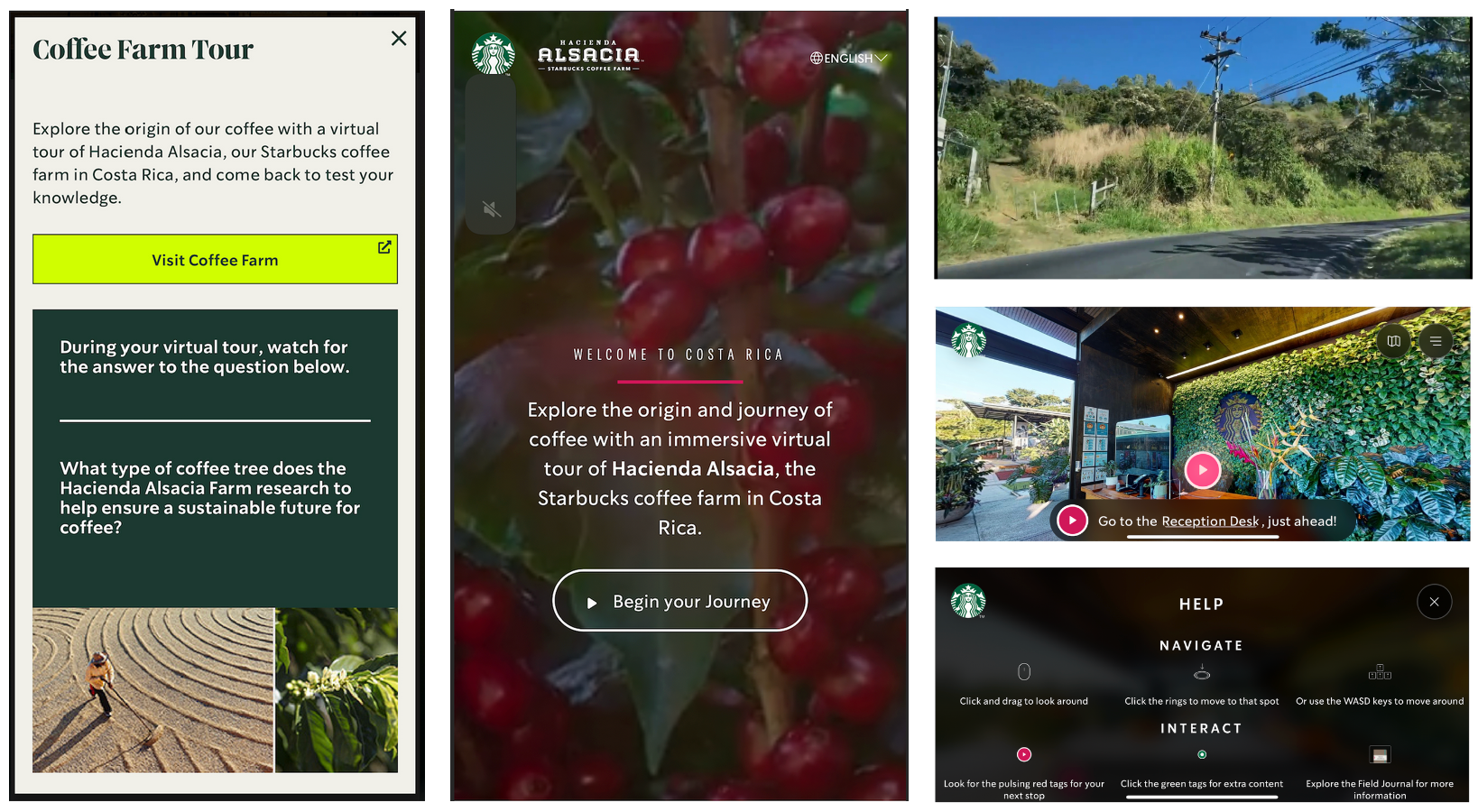
Virtual Tour -- This is the most impressive of the minigames, having high-quality video clips with a virtual coffee farm tour and pick-your-own-tour guide. Coupled with a quiz at the end to make sure you're paying attention, asking things like what types of coffee trees does Starbucks actively research in its wholly owned coffee farm in Costa Rica.
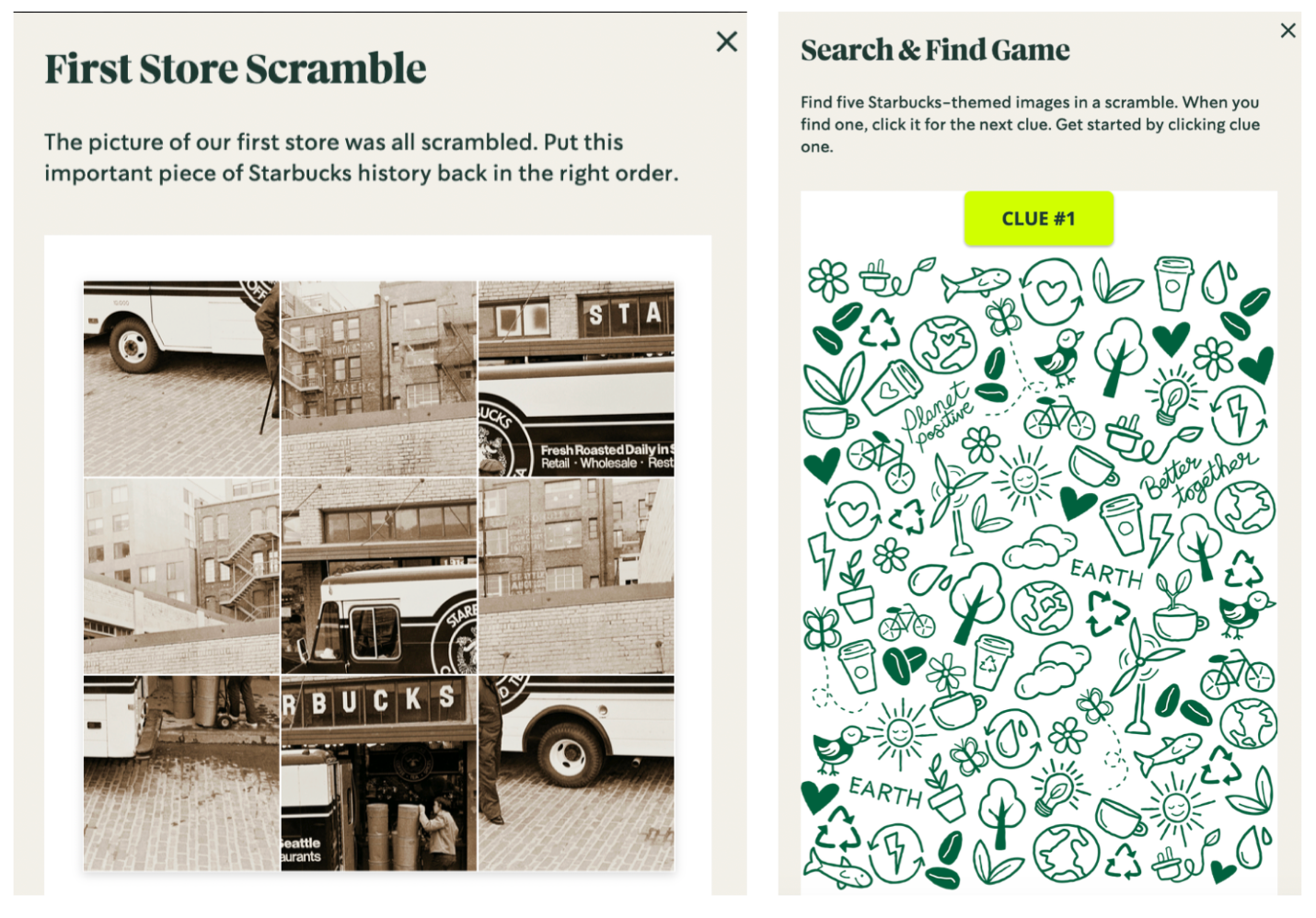
Puzzle Scrabble -- This involves a vintage picture of the first Starbucks store and requires players move the square pieces into the right spots to reconstruct the picture.
Hidden Objects — Similar to a hidden objects game, it has you find certain objects while also educating you on Starbucks’ sustainable initiatives like committing to using reusable cups (which then requires you find the reusable cup in the picture).
The lesson for web3 games is to focus on fun and prioritize the gaming experience above all else. The web3 technology should blend into the background. While none of the activities in Starbucks Odyssey provide a deep gaming experience that can keep players engaged for endless hours, that's not the main objective. Rather, the goal is to strengthen the connection with Starbucks, provide some educational value, and offer a bit of fun.
What's notably absent here, unlike most web3 projects, is the speculative culture, which often distracts from the core mission of a blockchain company or product. In this case, Starbucks has a clear goal in mind: to offer on-brand hooks wrapped in interactive minigames that keep things interesting and engaging, while wisely focusing on gameplay rather than hype.
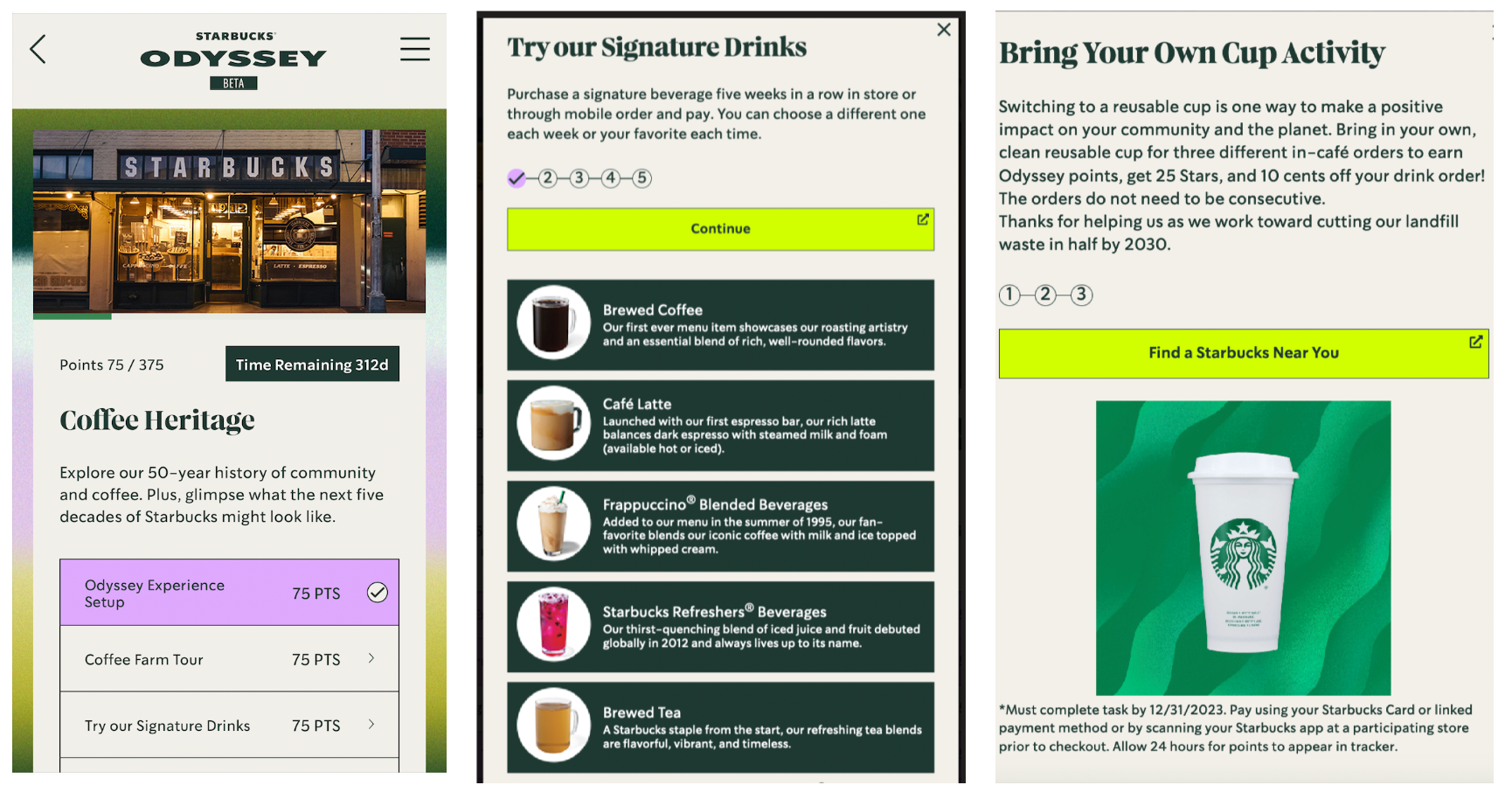
Lesson 2: Create Healthy Player Habits with Meaningful Game Objectives
Taking a look at Starbucks Odyssey through a gaming lens, one could argue that the main objective is to encourage customers to visit the store and drink coffee. Therefore, Starbucks' goal is to reinforce this "gaming loop" as much as possible. In this regard, Starbucks Odyssey has successfully accomplished this by introducing meaningful objectives (via Journeys) leading to player behavior changes.
Interwoven into each of the Journeys is usually a “game loop” drink challenge.Adam Brotman, the co-founder of web3 consultancy Forum3 (which partnered with Starbucks for Odyssey), described Journeys as “going to a Starbucks store you’ve never been to this week, or trying a Starbucks drink you’ve never tried.”
A key element of creating impactful game objectives is to influence and impact player behavior. If a challenge can be accomplished through passive behavior, it is far less engaging, interesting, and memorable. Instead, if a task requires players to modify their behavior and reinforces a "healthy habit," it becomes the holy grail of a great game objective.
So what does this actually look like? Let's take a look at one such “game loop” drink challenge: the "Bring Your Own Cup Activity.” This challenge requires you bring your own reusable cup to a Starbucks location three times, likely an uncommon customer behavior.
This challenge touches multiple areas, making it a meaningful and engaging game objective:
- Habit Forming: Making the player perform the activity multiple times enforces this "healthy habit" and lays a strong foundation to create a new future behavior and routine. Repetition will train the player to develop a routine, which will ultimately lead to a desired healthy habit.
- Rewards: It rewards the player in multiple ways. Customers save money (10c off), earn Stars (part of the regular Starbucks Loyalty program), earn Odyssey points to increase Benefit Level, and finally helps them get one step closer to completing the Journey to earn a coveted Stamp (aka NFT). Rewarding players in multiple ways incentivizes them to complete the activity regularly.
- Education: It educates the customer on a sustainable choice (bringing their own cup) they may not have been aware of. A gaming analogy might be educating the player about a booster they were previously unaware of or had never used before.
- Sensory Experience: Creating an activity that touches multiple senses deepens the experience. This checks multiple boxes; you can't just click a button and be done. For this task, you have to go find a usable cup (this in itself could be a treasure hunt rummaging through the pantry), walk/drive to a Starbucks, and then order with the reusable cup. For gaming, this means making the experience immersive with visual, auditory, and tactile feedback.
Typically, earning a Journey Stamp involves completing a coffee or drink challenge as part of the game loop, with the design goal of developing a new healthy habit for the player. Below is a list of these challenges, along with examples from the gaming world for inspiration.

For web3 gaming companies, the key takeaway is to design objectives that not only reinforce the core game loop but also develop challenges that force players out of their normal routines, ultimately creating a new desired habit. This could involve getting them to regularly use a high-value booster or incentivizing them to try out a new game mode.

Lesson 3: Grow The Community In a Carefully Controlled Manner
One key pillar and characteristic of web3 is community. But not all communities are equal, and Starbucks Odyssey’s approach is rather unique and an interesting case study.
With most web3 projects, after setting up the requisite Twitter handle, the very next step is usually setting up the Discord community and promoting the social element of the project on every platform. However, Starbucks Odyssey flipped the script on this.
The Discord community is not publicly open. Instead, you need a private invite and this is sent only at the end of the onboarding process. The Starbucks Odyssey team has been careful in crafting an accessible experience for web3 newbies. There’s a simple waitlist landing page where it's easy to sign up using just an email address. Next, you have to wait until the waitlist opens, which is done in controlled batches.
This means that Starbucks only allows a limited number of people in at a time to carefully manage the experience. Odyssey's first group was in early December 2022, and the company prioritized employees (called partners) to be early adopters and advocates of the program. This was a smart approach — with any beta program, you want early adopters to include your most loyal fans and advocates who will be most forgiving of early hiccups and provide much-needed feedback. This way, these early users ultimately become the best ambassadors for the program. Subsequent groups were allowed in from the waitlist on a rolling basis, with new Starbucks Odyssey players admitted every couple of months.
It's worth noting that everything discussed above utilizes traditional web2 tech, from a standard web sign-up page to using email as the primary communication channel. This is purposefully designed to onboard and build a community with tools that are most familiar to mainstream customers. The web3 tech is downplayed and hidden in the background, only for those who need or care to know about it (namely, if they want to trade Stamps). Instead, the main focus of the onboarding process is introducing players to the Odyssey program and helping them complete the Challenges to earn points and unlock Stamps. The Stamps themselves are not actively promoted as NFTs, even though that’s the underlying technology.
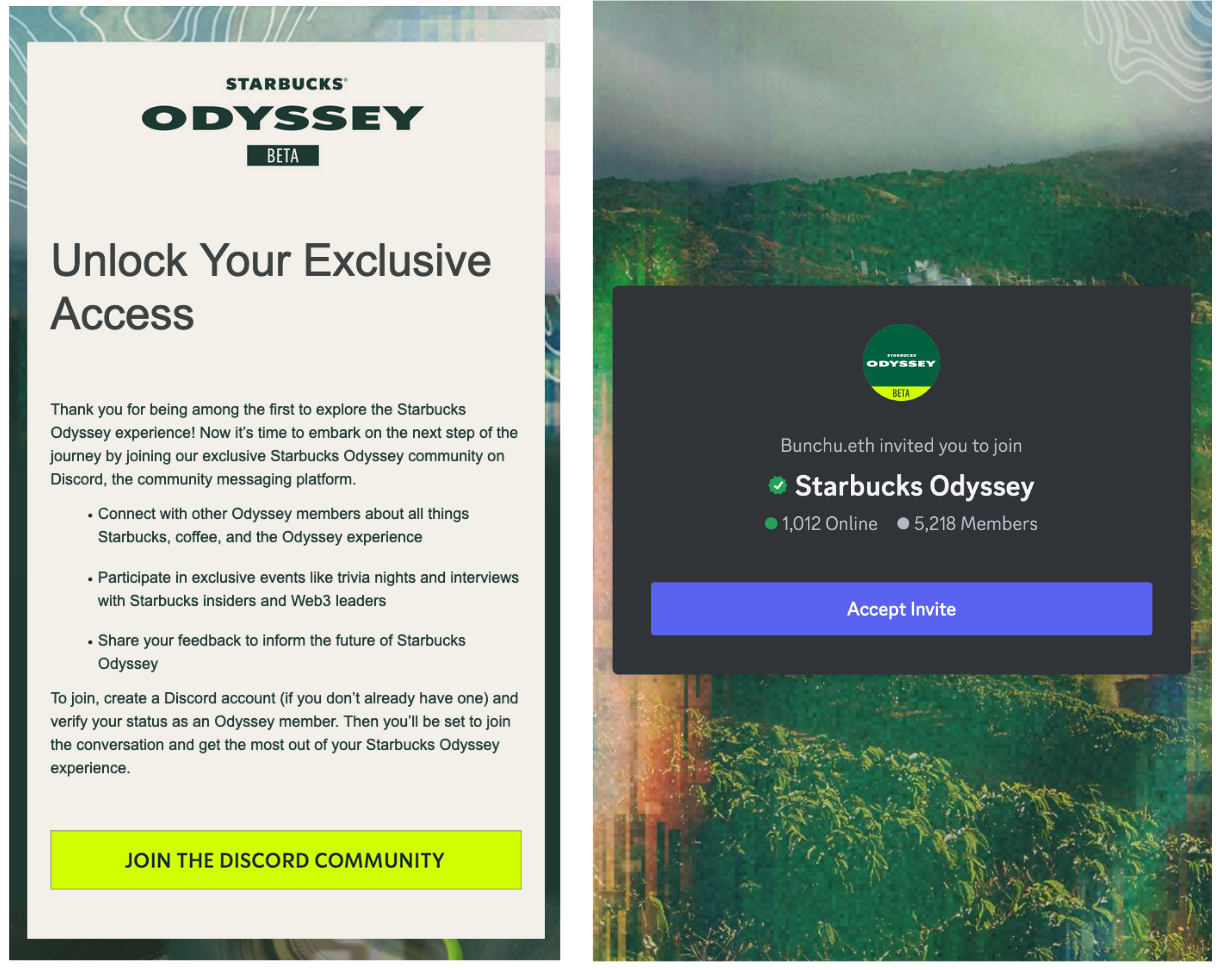
Finally, the last step of the onboarding process is the private Discord link. By design, this is only sent after completing some of the challenge tasks. Participation in Discord is completely optional as the core experience is via the website and interacting with the individual Journeys and earning Points and Stamps. However, Discord is where the experience really feels like a community and where all the latest info, tips, bugs, and upcoming announcements are shared and discussed.
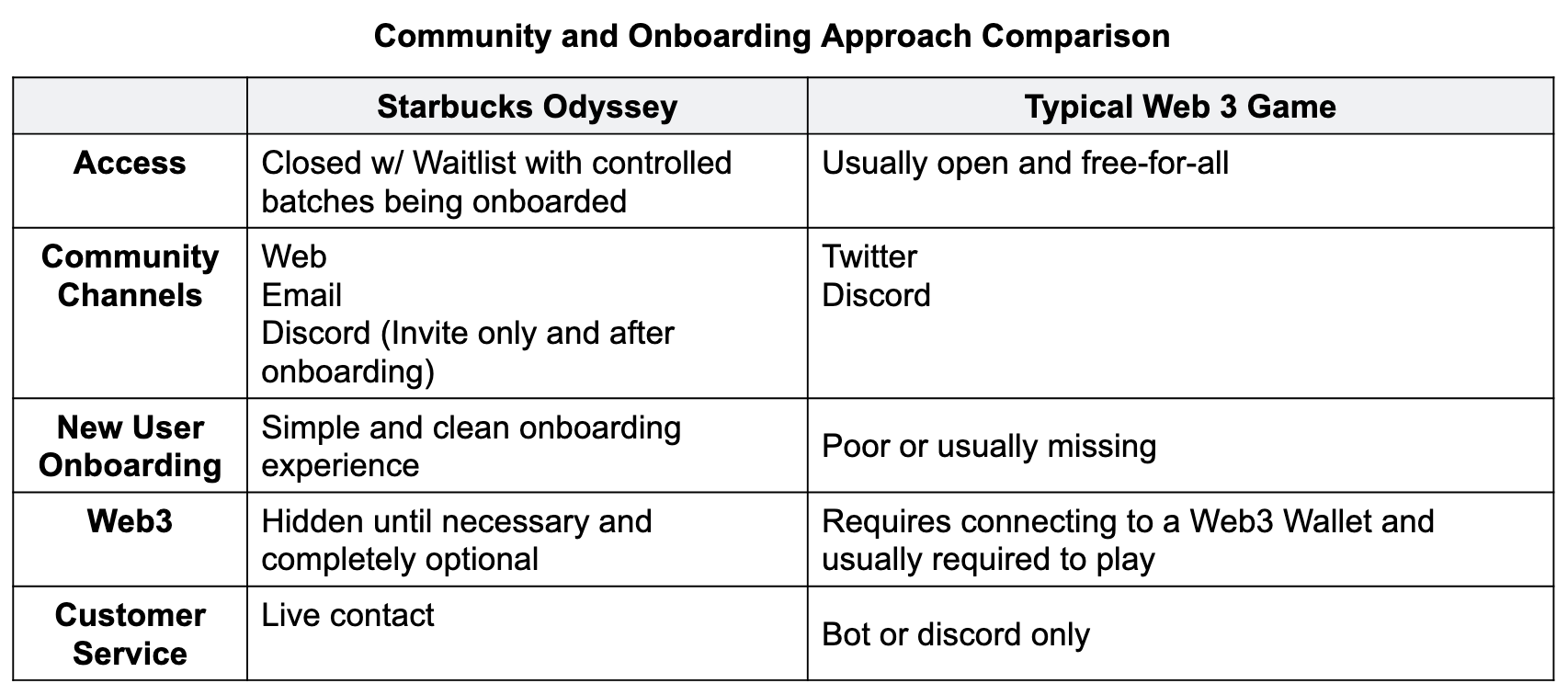
Web3 games can benefit from studying Starbucks Odyssey's controlled growth strategy, which prioritizes simplicity and familiarity for broad appeal. The use of a whitelist to carefully manage the community size helps ensure a consistently high-quality experience and robust customer support. Sending Discord invites at the end of onboarding, instead of at the beginning, establishes a strong foundation for community development. This approach emphasizes the central mission and goals, rather than the speculative culture commonly found in many other web3 projects. Moreover, by hiding the web3 technology in the background, new players can focus on completing challenges and Journeys without struggling to adopt new and unfamiliar concepts.
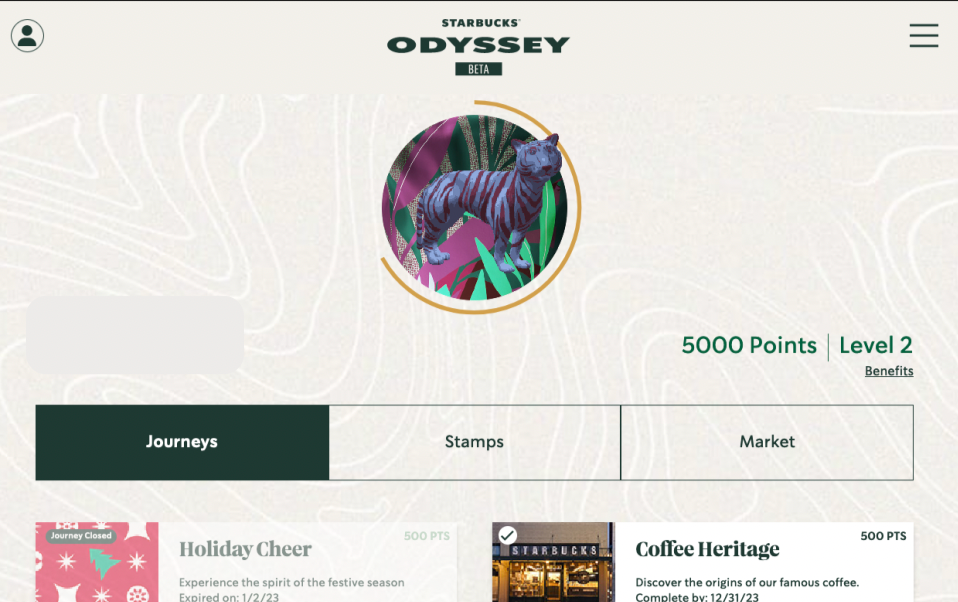
Lesson 4: Keep the UI and UX Simple to Focus On What’s Most Important
The actual Starbucks Odyssey experience is user-friendly both on mobile and desktop, although for some of the immersive experiences, such as the virtual coffee tour, it's best to use desktop. The user interface UI and UX are clean and clear, featuring a profile image with a circular meter that shows progress points followed by the player's name, current points, and current level. The navigation header is simple, with just three tabs for Journeys, Stamps, and the in-app marketplace.
Simple UI and UX make it very easy for players to onboard and navigate the experience. Note that the ordering is by design, with a built-in visual hierarchy from left to right that indicates the pathway that players should follow. This follows the natural Odyssey "game" lifecycle: Journeys to complete the task, Stamps that are unlocked by finishing Journeys, and finally a market to buy/sell Stamps, which is purposely gated until the player earns the first Stamp.
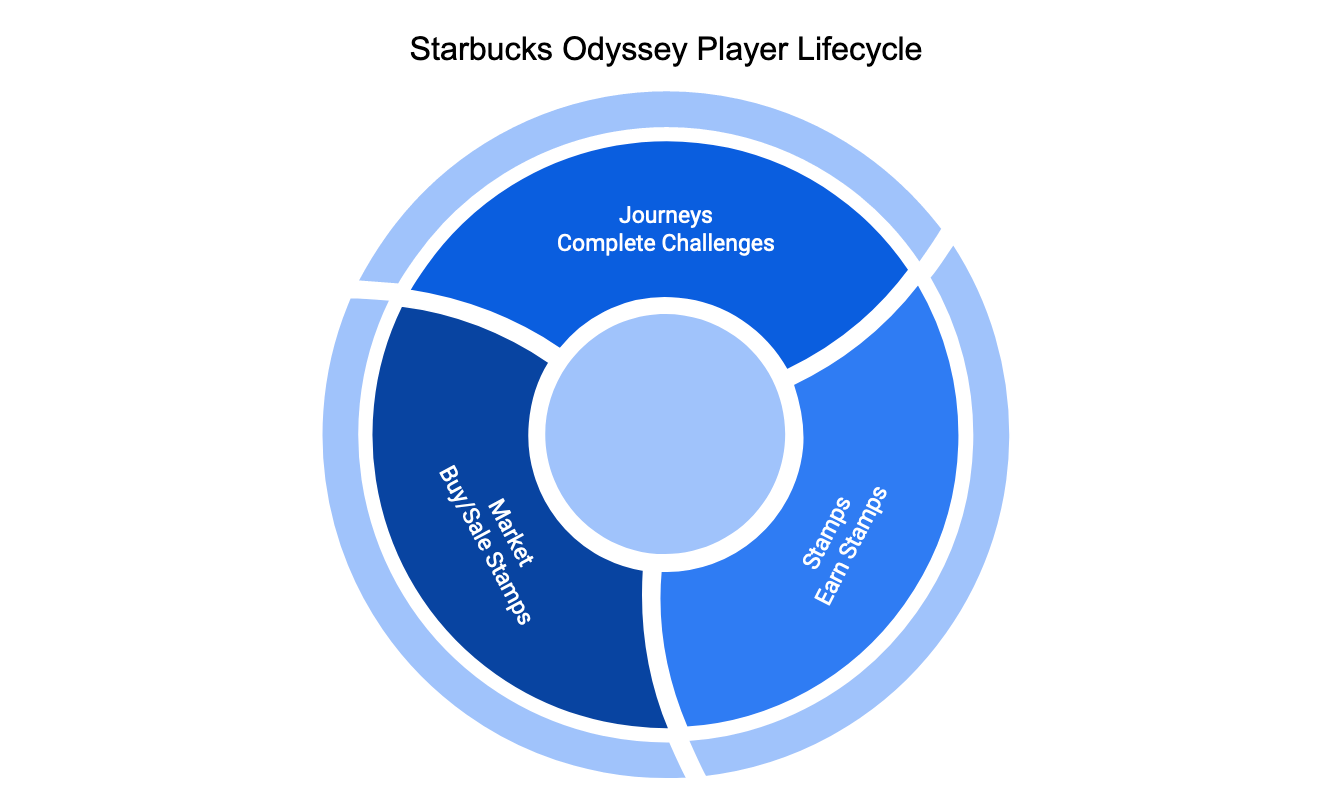
Journeys: This is the heart of the program in which players see the list of Journeys they can access. At its core, it's an achievement system to earn Points and Stamps. Opening each Journey will show the list of tasks with the current progress of each.
Stamps: This is the web3 experience where NFTs are minted on the Polygon blockchain, although Starbucks does not actively promote them as such. This tab functions just as an image gallery of your Journey Stamps. The only hint of anything web3-related is that each Stamp has a unique number. Outside of that it might as well be a photo album. There is no further interaction. This is perhaps by design to obscure the web3 details. Stamps do have associated Points value, which determine Player Benefits Levels which will determine reward perks. We’ll go more in depth on Starbucks Odyssey’s approach to Stamps/NFTs in the next lesson.
Market: This is more a launcher tab as it's simply a button that launches into the official custom Starbucks Odyssey marketplace which is powered by Nifty Gateway. This is the last tab and completely optional to the core experience. Those that are interested can jump over to Nifty Gateway marketplace to browse, buy, and sell all of the Starbucks Odyssey NFTs. Currently, the floor price of the various stamps range from around $60 to as high as $1,000, mainly driven by scarcity (Journeys that have already closed) and complexity of the challenges (drinking coffee five weeks in a row vs trying a new drink).
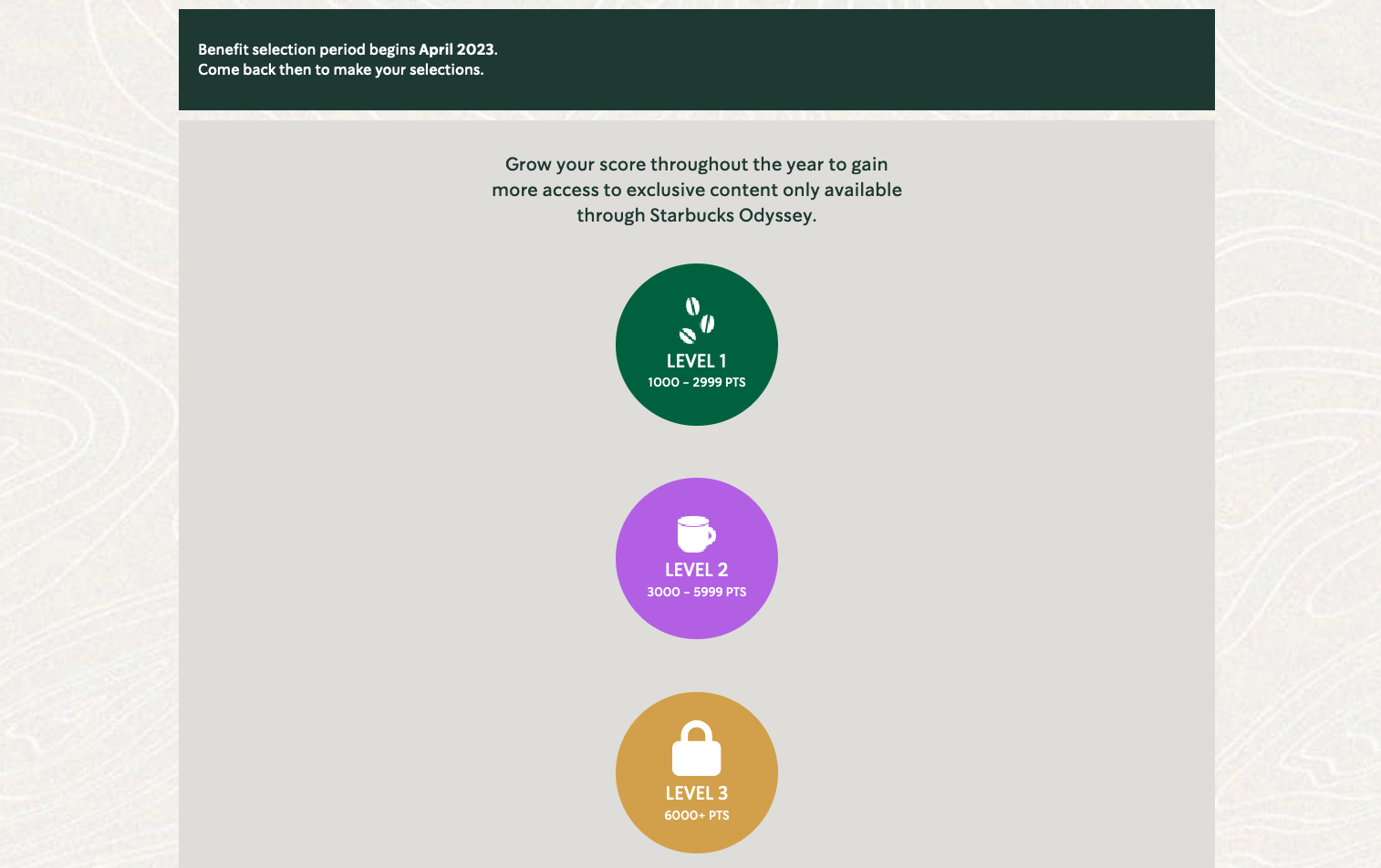
On top of the player loop is the accumulation of Points, which happens by completing Challenges and earning Stamps. Points determine the Benefit Level perks, such as exclusive merchandise and special events. The higher the level the more the benefits, with the highest level being Level 3. Points continue to accumulate for a year, after which they reset. This is similar to an airline loyalty program in which benefit levels need to be re-earned each year, ensuring customers are continually engaged.
Web3 games could benefit from following the lead of Starbucks Odyssey in keeping their UI/UX as simple as possible. This helps players focus on the most important aspects of the gaming experience, such as finishing Journeys by completing challenges to earn Stamps. In Starbucks Odyssey, the marketplace is deliberately placed at the end and only unlocked after earning the first Stamp. It's important to design the UI/UX in a way that emphasizes the game's core loop, which, for a good game, is never the technology, even if it's web3.

Lesson 5: Integrate NFTs Into the Player Meta System
The ultimate meta goal of the entire Starbucks Odyssey Experience is accumulating Points to achieve different benefit levels. These levels determine which rewards players can choose during various selection periods throughout the year. Points continue to accumulate, resetting annually.
During the benefits selection period, each benefit level offers three distinct reward choices. These vary from a special experience like a virtual coffee class, naming a coffee tree, or exclusive merch such as a custom cup with the image of the limited-edition Stamp you own. This is the only reward mechanism from the Starbucks Odyssey Experience, outside from selling the Stamps NFTs.

Since Points determine the Benefit Level and what perks players get to choose, earning Points is an important component of the Starbucks Odyssey Experience. Players earn Points in several ways:
- Challenges (80 Points each)
- Journey Stamps (125 Points)
- Limited-Edition Stamps (1,500 Points)
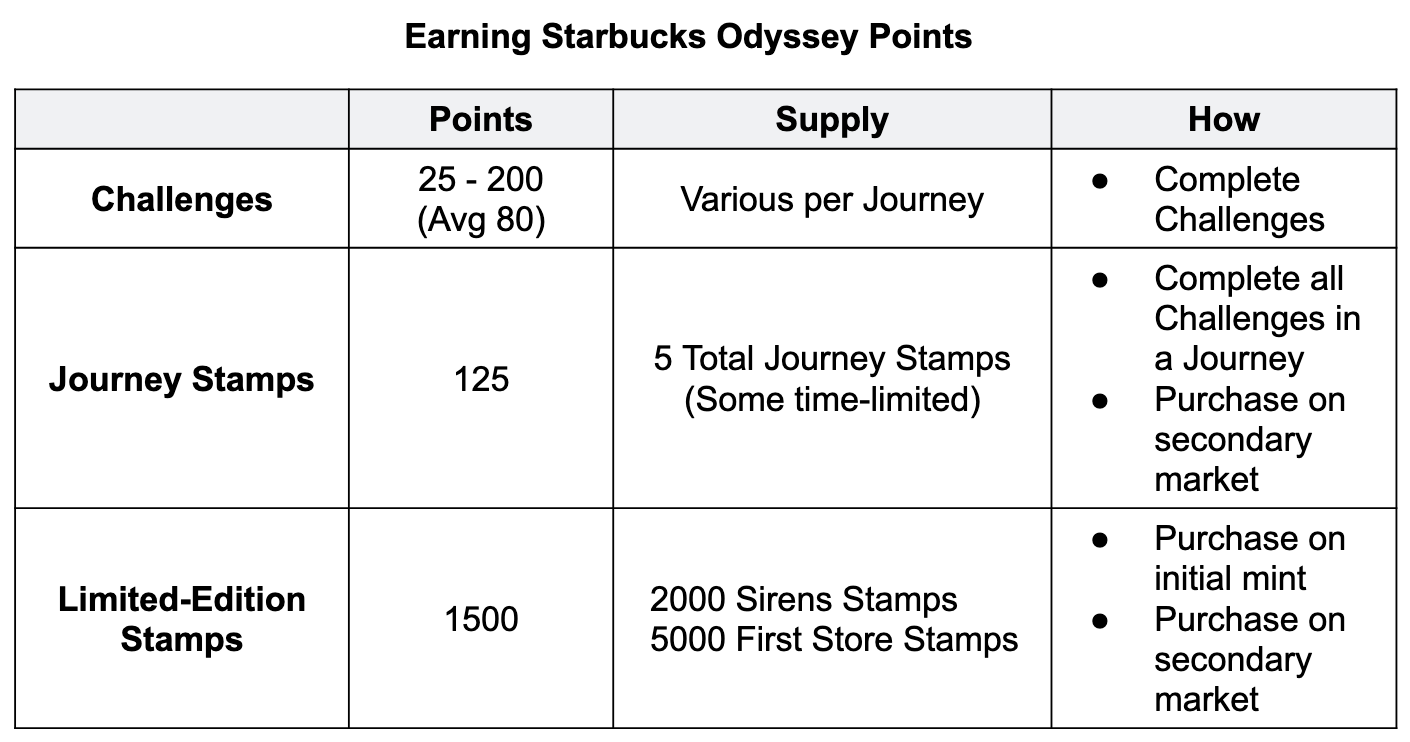
As you can see, Stamps play an integral role in the Points accumulation process. As NFTs that live on the Polygon blockchain, Stamps are unique in that they have associated Points, which can really accelerate the pace at which players move to the next benefit level. There are two tiers of Stamps: Journey Stamps, which have 125 Points, and Limited-Edition Stamps, which have 1,500 Points. As NFTs, Stamps can be bought and sold in the marketplace where the Stamps along with the associated Points are also transferred. This setup creates the opportunity for later players that missed out on earning points in expired Journeys opportunities to catch up by buying missing Stamps.
For instance, players entering this year missed out on the Holiday Cheer Journey available only during the launch month and so are unable to earn the Challenge points or the associated Stamp. However, if the player wants they can purchase the Holiday Cheer Stamp or any other missing Journey Stamp to gain a 125-point boost. Further the special Limited-Edition Stamp worth 1,500 Points is also available. It is worth noting that the associated point doesn’t translate to the marketplace floor, as all Journey Stamps have 125 points, but Holiday Cheer Journey Stamp has a floor of over $1,000. A more than 10x price of the other Journey Stamps, so the novelty of being the first Journey Stamp is elevating the marketplace price value — even though from a pure Points perspective it’s equal to any other Journey Stamp.
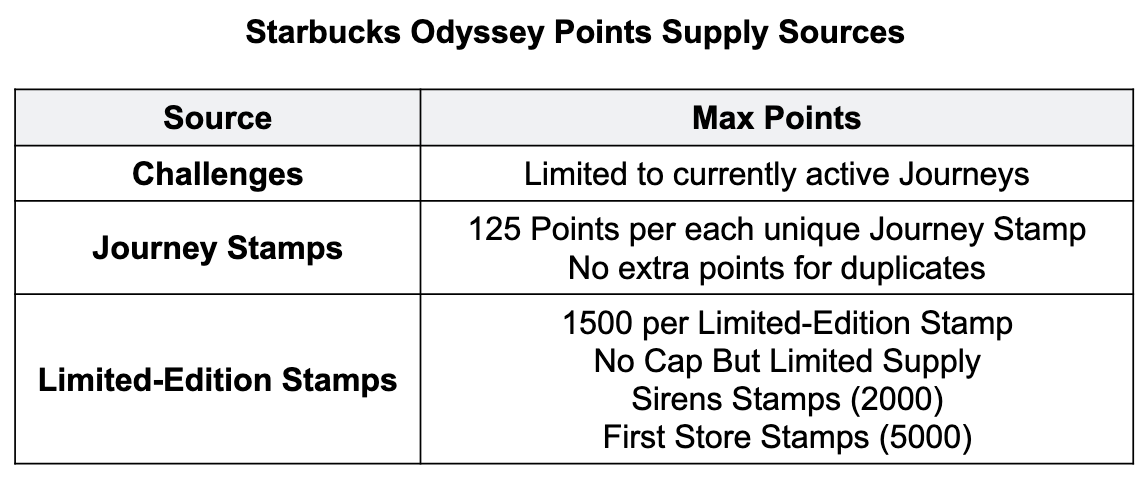
In terms of the Points economy, this creates an interesting player strategy in accumulating points. As a player only doing Challenges, you are essentially maxed out by what Journeys are available. If you want to advance to the higher Benefit Levels, that requires Limited-Edition Stamp ownership.
Looking at the benefit levels design, it’s 1,000 Points for Level 1, 3,000 Points for Level 2, and 6,000 Points for Level 3. Only five Journeys have been released at 500 Points each, which includes the 125 Points for the Journey Stamp. So a player who only completes challenges can earn a maximum of 2,500 Points, thus only achieving Level 1. However, this assumes the player started early and completed every Journeys. Some Journeys have time limits, and players who join now cannot earn Points for expired Journeys.
This creates a structure where players must purchase the Limited-Edition Stamps to achieve any of the upper Benefit Levels. To achieve Level 2, at least one Limited-Edition Stamp will be required and to achieve Level 3 you need at least three Limited-Stamps. This leans into the game design concept of the “near miss” or “desperate buy” where a player is so close to the next level that they ultimately convert and make the buy, in this case purchasing a Limited-Edition Stamp.
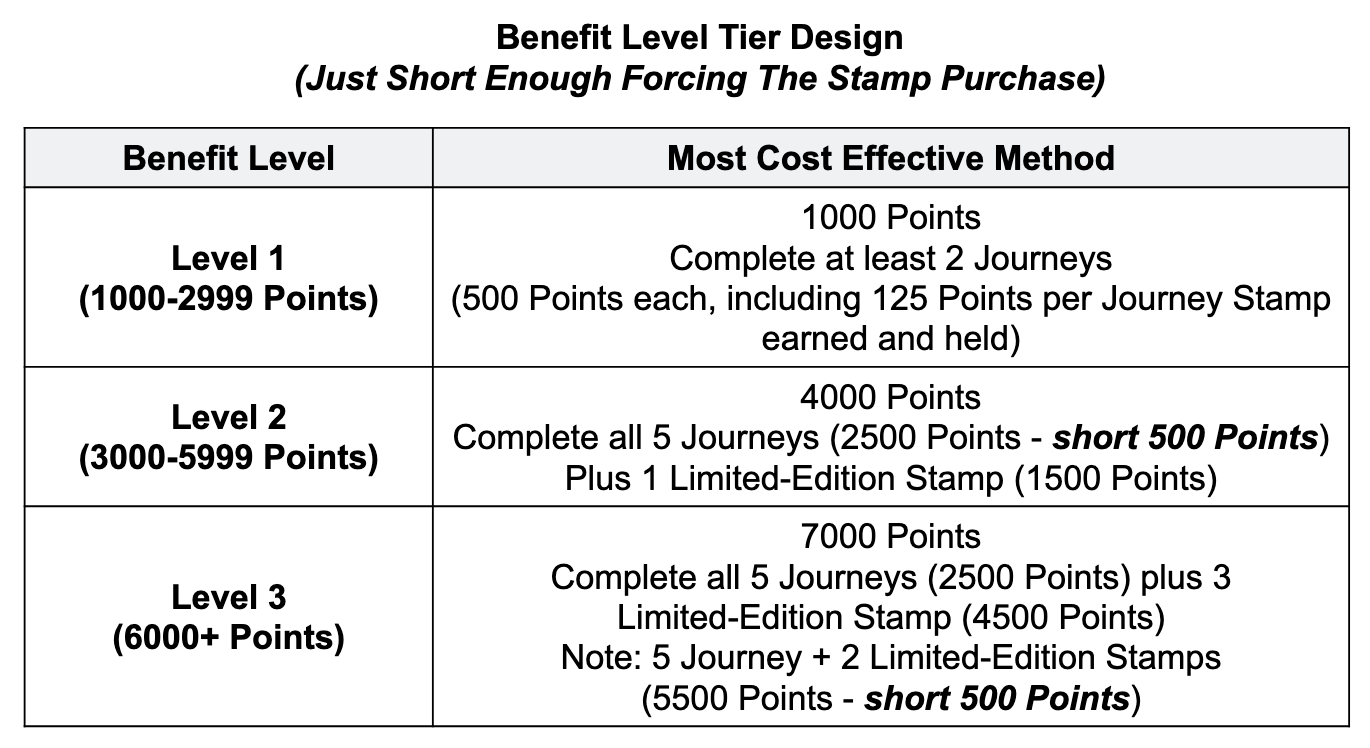
Furthermore, Starbucks Odyssey expertly timed their second Limited-Edition Stamp sale, the “First Store Collection,” with the first Benefit Level determination period. The Stamp sale occurred on April 19th, two days ahead of April 21st when the snapshot of current player Points occurred to determine Benefit Level. This no doubt created the added pressure of “last chance” to hit the next Benefit Level with a Limited-Edition Stamp purchase, all by design.
Stamps being powered as NFTs allows for the facilitation of digital ownership and the associated Points utility. The blockchain tech allows the Stamps to be freely traded in any open marketplace and not just the custom Starbucks Nifty Gateway Market, however most transactions still happen on the custom marketplace. Stamps being an NFT allows players to easily exit out of the Starbucks Odyssey ecosystem and extract value for their effort and coffee they drank. Other players are able to purchase these with the associated Points allowing them to “catch up.”
In theory, Stamps could have been created internally in a proprietary database and hosted on a private marketplace, but Starbucks leveraging open blockchain standards allows the company to focus on building a great player experience and not worry about the backend tech. Additionally, creating NFTs allows Stamps to have future utility beyond just Starbucks Odyssey.
As mentioned, there are two types of Stamps: Journey Stamps and Limited-Edition Stamps, which were purposefully introduced much later. Unlike many other web3 projects, Starbucks Odyssey did not do a hyped-up pre-sale and NFT drop as a quick "cash grab" scheme. Instead, the company waited and built up the community before the first NFT mint sale of its “Siren Collection.” Starbucks Odyssey is unique in its NFT sale approach and it’s worth taking a closer look.
The inaugural Starbucks Odyssey Stamp collection was 2,000 editions at a mint price of $100 each and paid tribute to Starbucks’ siren icon. Each Limited-Edition Stamp is worth 1,500 Points, helping players quickly advance to the next Benefit Level. If minting the max of two Stamps, a player could quickly earn 3,000 Points. For comparison, completing a Journey grants only 500 Points, including the 125 Points from the Journey Stamp. Thus a single Limited-Edition Stamp is worth completing three Journeys or 12x the Points of a Journey Stamp.
“The Siren Collection” Stamp sale was limited to only current Starbucks Odyssey players as opposed to a free-for-all as is typical with other web3 projects. Additionally, there was a maximum of only two mints to allow for wider participation. Even with these restrictions, the response was overwhelming with the whole purchase experience being reduced to a clicking war. “The Siren Collection” sold out in just 18 minutes. At the time of sale, many would-be minters were presented with slow loading pages and purchase time outs. Those lucky to make it through also experienced bugs such as double charges — not unheard of during a clicking war.
Even though it didn’t go as planned, when compared to other web3 NFT projects, the actual purchase/mint experience was definitely one of the better ones. An important factor that played into this was Starbucks Odyssey smartly partnering with Nifty Gateway, an established proven player. Many smaller web3 projects end up creating their own minting website, which often fails to scale to peak traffic and is vulnerable to bots and other bad actors.
Partnering with Nifty Gateway allowed Starbucks Odyssey to offload the marketplace experience to a trusted entity, one that could handle the NFT management including payment and the NFT minting onboarding experience. The mint could be purchased via credit card making it very accessible, and there was no need to link a bank account to move money, convert it to a cryptocurrency, and then load some external wallet to mint. In that way, working with Nifty Gateway broadens the accessibility. If someone can make a purchase on eBay, then they can as easily mint a Starbucks Odyssey Stamp.
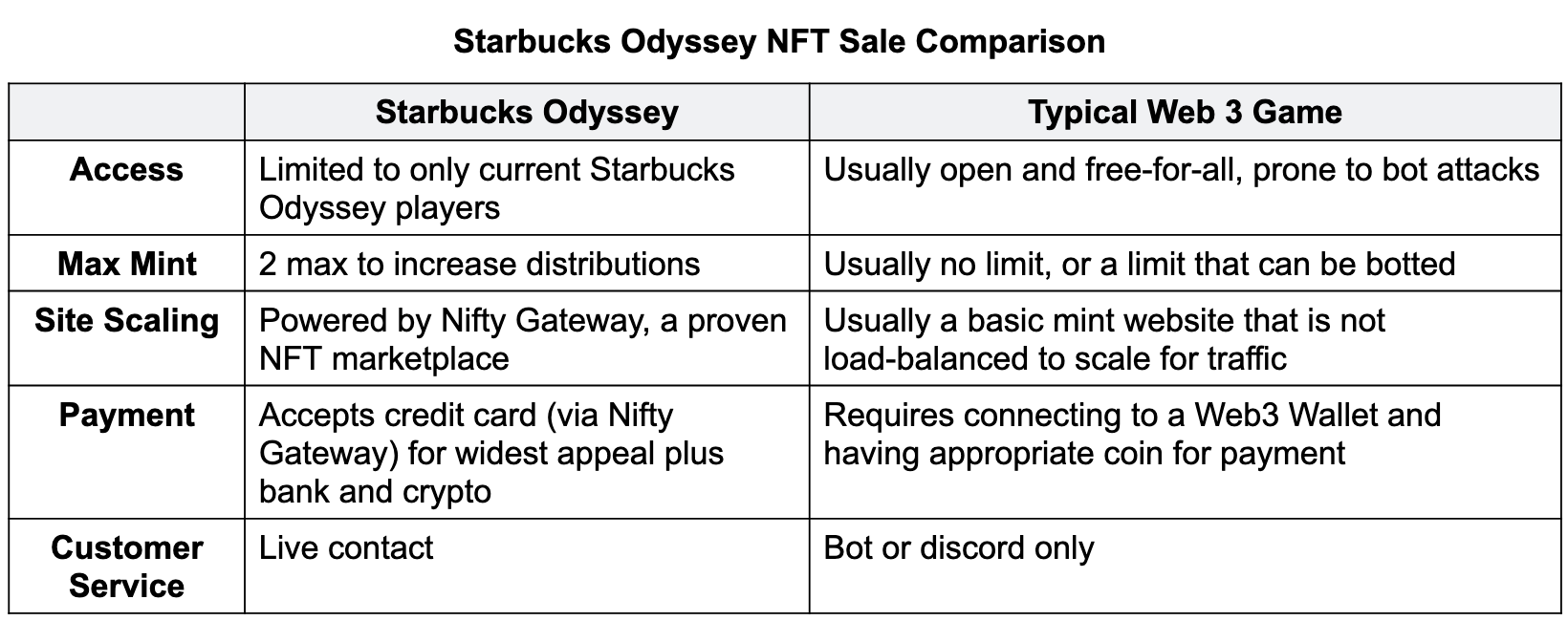
Given the less-than-ideal experience of the first Stamp sale, the Starbucks Odyssey team listened to the community and in the next upcoming mint made several key changes:
- Increased the supply to 5,000 to 2,000
- Increased the requirement to owning two stamps (before it was open to all Odyssey players)
- Lower the max mint to one from the previous two, increasing the chances of a fairer distribution and access
- Allow a larger mint window, this time three hours starting at 9AM
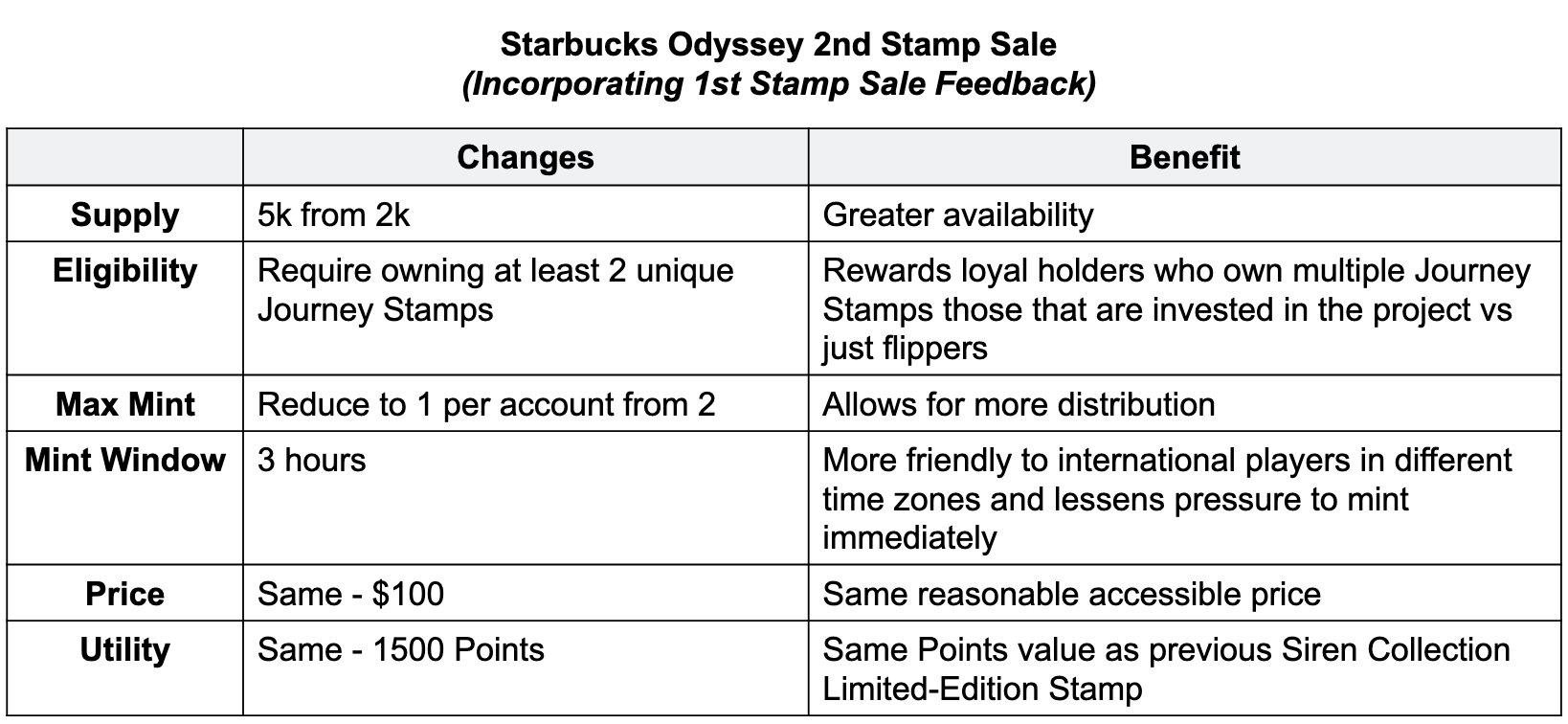
Starbucks Odyssey has taken a distinct measured approach with its NFT strategy. While most web3 projects will make a splashy initial pre-sale mint, instead Starbucks Odyssey focused on growing and nurturing the community first. Early on, it offered earning only Journey Stamps (with a moderate 125-point value) then later direct sale Limited-Edition Stamps (with a 1,500-point value). It integrated the Stamps into the overall meta Benefit Level system. Starbucks Odyssey cleverly constructed the Benefit Level tiers where, those that are seeking the higher levels must purchase the Limited-Edition Stamps by design.
Additionally, for the Limited-Edition Stamps mint Starbucks rewards their most loyal players, those that are in the Starbucks Odyssey Experience and Journey Stamp holders, thereby filtering out speculators. Starbucks Odyssey is constantly engaging and listening to the community that even with a less-than-perfect first mint, it actively solicited feedback for improvements that it then incorporated into its second mint for positive changes.
Web3 games can learn a lot from studying Starbucks NFT approach, including how it carefully rolled out different types (earning versus direct sale), wove NFTs into the overall meta benefit reward system, used a trusted NFT marketplace partner, constructed the reward benefit tiers to incentivize buys, and actively listened to the community for ongoing improvements.
Is It Worth It For Starbucks Odyssey Players?
Doing a quick cost-benefit analysis to reach the highest Benefit Level 3, we see participating in the Starbucks Odyssey Experience is both fun and financially rewarding. For a player that entered early and completed all the Journeys, the marketplace value of the Stamps alone easily offset the cost of the coffee. Furthermore, adding the Benefit Level 3 reward of 30 days of free coffee (up to $10 per day) for an additional $300 value is just icing on the cake.
All in, the theoretical profit is over $2,600 with an impressive ROI of +753%. Plus, this only includes the first benefit selection period; there are several throughout the year so the rewards and returns will just keep growing. Will this be sustainable in the long term? We’ll have to wait and see.

Key Takeaways
At first glance, Starbucks Odyssey looks like a big brand casually experimenting with new web3 technology without putting much thought into it. However, when examined through a gaming perspective, Starbucks Odyssey offers numerous valuable lessons to web3 game developers.
First, web3 games can benefit by focusing on creating fun experiences instead of just earning. Second, to establish healthy habits, effective systems should be created to support the core loop by encouraging behavior changes that are meaningful, like incorporating a new booster or trying out a new feature that can become part of a new routine. Third, though it may seem obvious, having a clean UI/UX interface can make the difference between an enjoyable player experience that appeals to the masses and a confusing and frustrating experience that leads to player churn.
Fourth, in Web3, community plays an outsize role compared to traditional gaming or loyalty programs. Starbucks Odyssey's measured approach helped it manage growth and deliver a superior experience to its customers, while integrating NFTs into the larger meta benefits system and designing reward tiers that require Limited-Edition Stamps gives the tokens real value, encouraging loyalty among holders rather than incentivizing fleeting speculators.
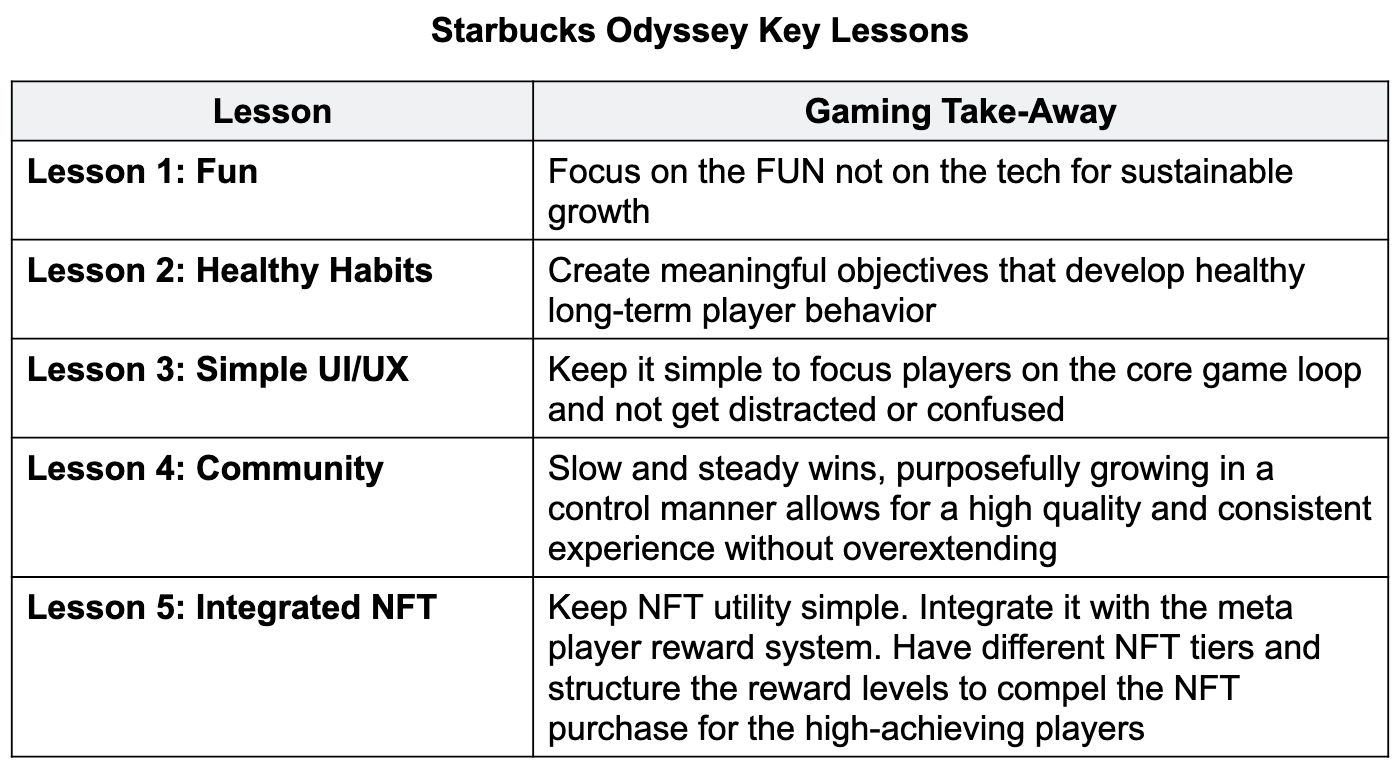
There are many valuable lessons to be learned from Starbucks Odyssey, and it would be beneficial for web3 games to delve deeper into it for additional inspiration and best practices. As demonstrated, gaming lessons can come from non-traditional sources, and it's important to keep an open mind and see everything as a potential source of insight. Even a seemingly simple loyalty program that encourages people to drink more coffee can yield a treasure trove of valuable game-related knowledge in the context of web3.
A big thanks to Lawrence Hsieh for writing this essay! If Naavik can be of help as you build or fund games, please reach out.




